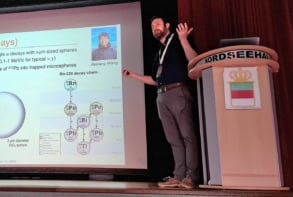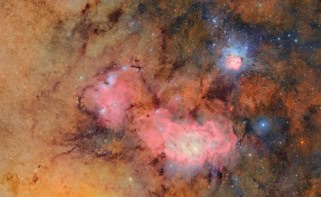The Grand Design
Stephen Hawking and Leonard Mlodinow
2010 Bantam Press £18.99hb 208pp

The Grand Design begins with a series of questions: “How can we understand the world in which we find ourselves?”, “How does the universe behave?”, “What is the nature of reality?”, “Where did all this come from?” and “Did the universe need a creator?”. As the book’s authors, Stephen Hawking and Leonard Mlodinow, point out, “almost all of us worry about [these questions] some of the time”, and over the millennia, philosophers have worried about them a great deal. Yet after opening their book with an entertaining history of philosophers’ takes on these fundamental questions, Hawking and Mlodinow go on to state provocatively that philosophy is dead: since philosophers have not kept up with the advances of modern science, it is now scientists who must address these large questions.
Much of the rest of the book is therefore devoted to a description of the authors’ own philosophy, an interpretation of the world that they call “model-dependent realism”. They argue that different models of the universe can be constructed using mathematics and tested experimentally, but that no one model can be claimed as a true description of reality. This idea is not new; indeed, the Irish philosopher and bishop George Berkeley hinted at it in the 18th century. However, Hawking and Mlodinow take Berkeley’s idea to extremes by claiming that since many models of nature can exist that describe the experimental data equally well, such models are therefore equally valid.
It is important to the argument of the book – which leads eventually to more exotic models such as M-theory and the multiverse – that readers accept the premise of model-dependent realism. However, the history of science shows that the premise of one model being as good and useful as another is not always correct. Paradigms shift because a new model not only fits the current observational data as well as (or better than) an older model, but also makes predictions that fit new data that cannot be explained by the older model. Hawking and Mlodinow’s assertion that “there is no picture- or theory-independent concept of reality” thus flies in the face of one of the basic tenets of the scientific method.
Consider the Ptolemaic model of the solar system, in which the planets move in circular orbits around the Earth, and the heliocentric model put forward by Copernicus. The authors suggest that the two models can be made to fit the astronomical data equally well, but that the heliocentric model is a simpler and more convenient one to use. Yet this does not make them equivalent. New data differentiated them: Galileo’s observation of the phases of Venus, through his telescope, cannot easily be explained in Ptolemy’s Earth-centred system. Similarly, Einstein’s theory of gravity superseded Newton’s laws of gravitation when its equations correctly described Mercury’s anomalous orbit. One theory, one perception of reality, is not just as good as another, and this can be shown empirically: Einstein’s gravity is even used to make corrections to Newton’s in the Global Positioning System.
It is true, however, that the situation in quantum mechanics has not yet been resolved. Several different models, such as the “many worlds” interpretation of Hugh Everett III, the Copenhagen interpretation and certain Bohmian hidden-variable models, all agree with quantum-mechanical experiments, and as yet none of the interpretations has produced a prediction that would experimentally differentiate them. Based on the history of science, however, we have no reason to assume that in the future there will not be a decisive experiment that will support one model over the others.
A second premise that the reader is expected to accept as The Grand Design moves along is that we can, and should, apply quantum physics to the macroscopic world. To support this premise, Hawking and Mlodinow cite Feynman’s probabilistic interpretation of quantum mechanics, which is based on his “sum over histories” of particles. Basic to this interpretation is the idea that a particle can take every possible path connecting two points. Extrapolating hugely, the authors then apply Feynman’s formulation of quantum mechanics to the whole universe: they announce that the universe does not have a single history, but every possible history, each one with its own probability.
This statement effectively wipes out the widely accepted classical model of the large-scale structure of the universe, beginning with the Big Bang. It also leads to the idea that there are many possible, causally disconnected universes, each with its own different physical laws, and we occupy a special one that is compatible with our existence and our ability to observe it. Thus, in one fell swoop the authors embrace both the “multiverse” and the “anthropic principle” – two controversial notions that are more philosophic than scientific, and likely can never be verified or falsified.
Another key component of The Grand Design is the quest for the so-called theory of everything. When Hawking became Lucasian Professor of Mathematics at Cambridge University – the chair held by, among others, Newton and Paul Dirac – he gave an inaugural speech claiming that we were close to “the end of physics”. Within 20 years, he said, physicists would succeed in unifying the forces of nature, and unifying general relativity with quantum mechanics. He proposed that this would be achieved through supergravity and its relation, string theory. Only technical problems, he stated, meant that we were not yet able to prove that supergravity solved the problem of how to make quantum-gravity calculations finite.
But that was in 1979, and Hawking’s vision of that theory of everything is still in limbo. Underlying his favoured “supergravity” model is the postulate that, in addition to the known observable elementary particles in particle physics, there exist superpartners, which differ from the known particles by a one-half unit of quantum spin. None of these particles has been detected to date in high-energy accelerator experiments, including those recently carried out at the Large Hadron Collider at CERN. Yet despite this, Hawking has not given up on a theory of everything – or has he?
After an entertaining description of the Standard Model of particle physics and various attempts at unification, Hawking and his co-author conclude that there is indeed a true theory of everything, and its name is “M-theory”. Of course, no-one knows what the “M” in M-theory stands for, although “master”, “miracle” and “mystery” have been suggested. Nor can anyone convincingly describe M-theory, except that it supposedly exists in 11 dimensions and contains string theory in 10 dimensions. A problem from the outset with this incomplete theory is that one must hide, or compactify, the extra seven dimensions in order to yield the three spatial dimensions and one time dimension that we inhabit. There is a possibly infinite number of ways to perform this technical feat. As a result of this, there is a “landscape” of possible solutions to M-theory, 10500 by one count, which for all practical purposes also approaches infinity.
That near-infinity of solutions might be seen by some as a flaw in M-theory, but Hawking and Mlodinow seize upon this controversial aspect of it to claim that “the physicist’s traditional expectation of a single theory of nature is untenable, and there exists no single formulation”. Even more dramatically, they state that “the original hope of physicists to produce a single theory explaining the apparent laws of our universe as the unique possible consequence of a few simple assumptions has to be abandoned”. Still, the old dream persists, albeit in a modified form. The difference, as Hawking and Mlodinow assert pointedly, is that M-theory is not one theory, but a network of many theories.
Apparently unconcerned that theorists have not yet succeeded in explaining M-theory, and that it has not been possible to test it, the authors conclude by declaring that they have formulated a cosmology based on it and on Hawking’s idea that the early universe is a 4D sphere without a beginning or an end (the “no-boundary theory”). This cosmology is the “grand design” of the title, and one of its predictions is that gravity causes the universe to create itself spontaneously from nothing. This somehow explains why we exist. At this point, Hawking and Mlodinow venture into religious controversy, proclaiming that “it is not necessary to invoke God to light the blue touch paper and set the universe going”.
Near the end of the book, the authors claim that for a theory of quantum gravity to predict finite quantities, it must possess supersymmetry between the forces and matter. They go on to say that since M-theory is the most general supersymmetric theory of gravity, it is the only candidate for a complete theory of the universe. Since there is no other consistent model, then we must be part of the universe described by M-theory. Early in the book, the authors state that an acceptable model of nature must agree with experimental data and make predictions that can be tested. However, none of the claims about their “grand design” – or M-theory or the multiverse – fulfils these demands. This makes the final claim of the book – “If the theory is confirmed by observation, it will be the successful conclusion of a search going back 3000 years” – mere hyperbole. With The Grand Design, Hawking has again, as in his inaugural Lucasian Professor speech, made excessive claims for the future of physics, which as before remain to be substantiated.



